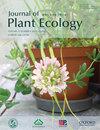青藏高原高寒草地植物群落特征与功能在降水梯度上调节生物量平衡
IF 3.9
2区 环境科学与生态学
Q2 ECOLOGY
引用次数: 0
摘要
更好地理解不同生态系统中植物生物量分配的机制是阐明植物适应策略的重要理论基础。迄今为止,生境条件对植物生物量分配的影响已经得到了广泛的研究。然而,植物群落特征和功能(PCTF)如何影响生物量分配,特别是在高寒草地生态系统中,尚不清楚。本研究利用5个叶片功能性状在群落水平上计算群落加权平均值(CWM),并利用相关分析、变异分配分析和结构方程模型探讨PCTF与生物量权衡之间的关系。结果表明,青藏高原高寒草甸(AM)和高寒草原(AS)的权衡值均大于零,AM和AS的权衡值分别为0.203和0.088。此外,决定AS生物量分配的关键因素是物种丰富度(SR;分值为0.69)和叶片干物质含量(CWMLDMC,分值为0.42),而在AM中,关键因子是叶片干物质含量(CWMLDMC,分值为0.48)和叶片碳含量(CWMLC,分值为- 0.45)。其中,旱地CWMLDMC和SR以及旱地CWMLDMC和CWMLC主要受降水调节。综上所述,降水倾向于通过对PCTF的影响来驱动高寒草原的生物量分配,从而突出了PCTF在调节植物生物量沿降水梯度分配策略中的重要性。本文章由计算机程序翻译,如有差异,请以英文原文为准。
Plant community traits and functions mediate the biomass trade-off of alpine grasslands along precipitation gradients on the Tibetan Plateau
Abstract A better understanding the mechanisms driving plant biomass allocation in different ecosystems is an important theoretical basis for illustrating the adaptive strategies of plants. To date, the effects of habitat conditions on plant biomass allocation have been widely studied. However, it is less known how plant community traits and functions (PCTF) affect biomass allocation, particularly in alpine grassland ecosystems. In this study, community-weighted means (CWM) were calculated at the community level using five leaf functional traits, and the relationships between PCTF and biomass trade-offs were explored using correlation analysis, variation partitioning analysis and structural equation modeling. We found that the trade-off values were greater than zero in both alpine meadow (AM) and alpine steppe (AS) across the Tibetan Plateau, with different values of 0.203 and 0.088 for AM and AS, respectively. Moreover, the critical factors determining biomass allocation in AS were species richness (SR; scored at 0.69) and leaf dry matter content of CWM (CWMLDMC, scored at 0.42), while in AM, the key factors were leaf dry matter content (CWMLDMC, scored at 0.48) and leaf carbon content of CWM (CWMLC, scored at −0.45). In particular, both CWMLDMC and SR in AS, as well as CWMLDMC and CWMLC in AM were primarily regulated by precipitation. In summary, precipitation tends to drive biomass allocation in alpine grasslands through its effects on PCTF, hence highlighting the importance of PCTF in regulating plant biomass allocation strategies along precipitation gradients.
求助全文
通过发布文献求助,成功后即可免费获取论文全文。
去求助
来源期刊

Journal of Plant Ecology
生物-植物科学
CiteScore
4.60
自引率
18.50%
发文量
134
审稿时长
3 months
期刊介绍:
Journal of Plant Ecology (JPE) serves as an important medium for ecologists to present research findings and discuss challenging issues in the broad field of plants and their interactions with biotic and abiotic environment. The JPE will cover all aspects of plant ecology, including plant ecophysiology, population ecology, community ecology, ecosystem ecology and landscape ecology as well as conservation ecology, evolutionary ecology, and theoretical ecology.
 求助内容:
求助内容: 应助结果提醒方式:
应助结果提醒方式:


